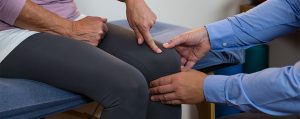Why Does It Hurt When I Sit?
In the past year many of us have been juggling the challenges of working from home. With this comes changes in work setups, changes in hours worked, and the blurring of work and home spaces. The combination of these changes may be contributing to aches and pain in various body parts. If you continue to work remote or are transitioning back to office life, here are some helpful tips.
Workplace Ergonomics: Long-Term Tips for Working from Home
This year has seen a drastic increase in the number of people working from home. This change was sudden and unplanned for many people. Therefore, scores of people have turned their kitchen countertops and dining room tables into a home office. Many have gone from more ergonomically-sound setups in an office to a quick makeshift setup at home. The following are long-term tips for those working from home for the foreseeable future.
Ergonomic Do’s and Don’ts: Long Term Home Office/Classroom Tips
By now we have all begun to adapt to our new lifestyle amidst the COVID-19 pandemic. It is pretty remarkable how quickly we can alter our daily lives to fit the ongoing changes that 2020 has brought on. For better or worse, much of these changes are centered around technology. We now rely heavily on platforms like Zoom and Facetime for e-learning, working virtually from home, and even connecting socially with family and friends. Though technology has made all of this possible, it does have one major downfall: promoting poor posture.
Stretch for Success: 10 Exercises & Stretches To Help Improve Your Posture
Working from home has been a major change in many people’s life during 2020. One of the downsides may be the increased sedentary time. Unless you have committed to a daily exercise routine, you may lose activities such as walking to your car and walking into the office, doing a flight of stairs to get in your building, or rushing over to a meeting down the hall. With winter on the way, it may be even more difficult to get in a walk outside at lunch. Here are ten stretches and activities that you can do to improve posture throughout the day, increase your activity level, and decrease pain from constantly sitting.
What Is Upper Cross Syndrome/Lower Cross Syndrome?
Upper cross syndrome and lower cross syndrome are terms heard within the world of medicine that, on the surface, sound a little intimidating. However, each term simply refers to muscle weakness and tightness in certain areas of the body that may be contributing to pain and/or reduced functional level. Each “syndrome” entails two predominant areas of muscle tightness and two predominant areas of muscle weakness. Often times, these limitations occur as a result of impaired posture and can lead to pain. Once identified, both upper cross and lower cross syndromes can be effectively treated and managed with physical therapy care.
Low Back Pain in Young Adults
Low back pain is one of the most common ailments treated in outpatient physical therapy clinics today. Back pain can be debilitating and negatively affect quality of life to a large degree, and as a younger individual, it is something that is not often thought of as a potential injury. Yet, low back pain is fairly common in the younger population; up to 10-25% of the population in their late teens to early 40s report back pain. In this age group, low back is commonly described in the research as “non-specific back pain,” meaning back pain does not have a known cause or correlation to MRI or X-Ray imaging. Most acute, non-specific back pain usually resolves on its own within 6 weeks and with appropriate rest, good nutrition, light activity and a positive outlook, you can help manage the severity of your pain.
9 Exercises to Strengthen Your Neck & Shoulders
We are fortunate to have the modern advances and the benefits of electronic devices, remote education and networking, cushioned seats and postural supportive office chairs. All these things have become increasingly more abundant in our daily lives, however, the detriment of longer commutes, hours working on a laptop and evenings slouched or reclining on the couch in the company of televisions, tablets, and smartphones can often contribute to an increased tendency for neck pain, “tightness,” and muscle dysfunction.
3 Ways to Increase Your Well-Being during the Pandemic
Physical activity is important now more than ever with trends in COVID-19 cases being related to chronic illness. Physical activity not only helps with preventing chronic disease, it also improves daily life and mental health. By staying active, you are able to maintain and improve your range of motion and strength to perform the activities that make up your day. Here are three recommendations to help increase your health and well-being while staying at home during the COVID-19 outbreak.
